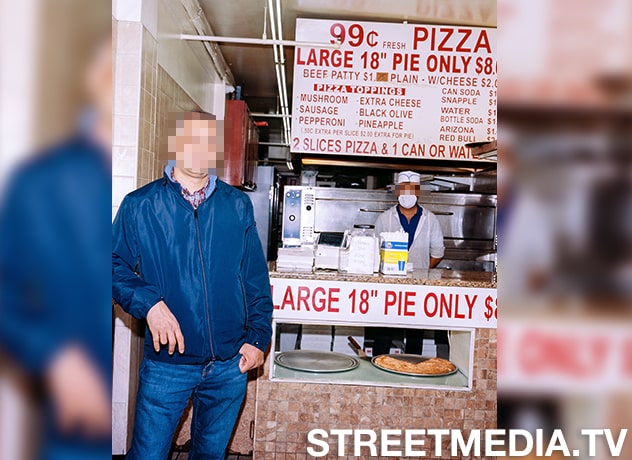Customers Go Behind the Kitchen in a $1 Slice Pizza Shop in NYC and Reveal Unsanitary Practices

Recently, two customers at a $1 dollar slice pizza shop in New York City decided to take matters into their own hands and expose what was really going on behind the kitchen. After ordering a few slices of pizza and watching the workers in the back, they noticed something shocking: one of the workers was kneading the dough with his bare feet on the dirty floor. In shock and disgust, they decided to record the scene and share it with the world.
The video quickly went viral, causing outrage and concern from people all over the world. Many were shocked to see such unsanitary conditions in a food establishment, and others were concerned about the health risks that could come from eating food prepared in such a way. The $1 dollar slice pizza shop quickly became the center of attention, with people calling for it to be shut down and the workers to be held accountable.
But this incident raises larger questions about the food industry and the conditions that workers are forced to work in. Many low-wage workers in the food industry are subject to poor working conditions, including long hours, low pay, and lack of basic benefits such as healthcare and sick days. These workers are often unable to take time off when they are sick, which can lead to them coming into work and potentially spreading illness to customers.
In addition to poor working conditions, the food industry is also notorious for its lack of regulation and oversight. Many food establishments operate without proper licensing or inspection, which can lead to unsafe conditions for workers and customers alike. And when incidents like the one at the $1 dollar slice pizza shop are exposed, it can be difficult to hold the establishment accountable and ensure that changes are made.
So what can be done to improve conditions in the food industry? One solution is to increase regulation and oversight of food establishments, ensuring that they are following proper procedures and maintaining safe working conditions. This can be accomplished through increased funding for regulatory agencies and more stringent licensing requirements for food establishments.
Another solution is to improve working conditions for food workers, including higher wages, better benefits, and safer working environments. This can be accomplished through labor organizing and advocacy, as well as through government action such as increased minimum wage laws and improved worker protections.
While street food is a beloved part of New York City’s food culture, it’s no secret that the city’s food sanitation standards have long been a topic of concern. In fact, a 2019 investigation by the New York Daily News found that almost 4,000 of the city’s restaurants had been cited for “critical” violations, meaning they pose an immediate risk to public health.
Street vendors, in particular, often operate under less strict regulations than brick-and-mortar establishments, and their food preparation and storage practices can be questionable. Food poisoning is a common issue among New Yorkers who frequently indulge in street food, with symptoms ranging from mild nausea to hospitalization.
One of the biggest culprits of food poisoning is cross-contamination, where bacteria from raw meats and other foods can easily spread to other surfaces and utensils. This can happen when vendors use the same cutting board or knife for multiple ingredients without properly sanitizing them.
Another issue is temperature control. Many vendors lack proper refrigeration or heating equipment, and food can quickly spoil in the hot and humid New York City climate. This can result in bacteria growth and cause foodborne illnesses.
While the city’s health department has made efforts to improve food safety, including increasing fines for violations and providing education to vendors, there is still a long way to go. Consumers can also take steps to protect themselves, such as choosing vendors with clean and well-maintained equipment, watching for proper hand hygiene, and avoiding foods that have been sitting out for long periods of time.
In the case of the $1 dollar slice pizza shop, the unhygienic dough kneading practices that were exposed by the customers are just one example of the unsanitary conditions that are all too common in many New York City food establishments. This incident serves as a reminder that consumers should always be aware of the potential risks associated with eating street food and take precautions to protect their health.
It still remains to be seen what action will be taken by New Yorks Health Department. The shop has since not been shut down by health inspectors, but the workers involved in the incident have been fired. But this incident serves as a reminder of the importance of ensuring safe working conditions and proper oversight in the food industry.
In conclusion, the incident at the $1 dollar slice pizza shop in New York City highlights the need for increased regulation and oversight of the food industry, as well as improved working conditions for food workers. By working together to address these issues, we can ensure that everyone has access to safe, healthy, and affordable food.



